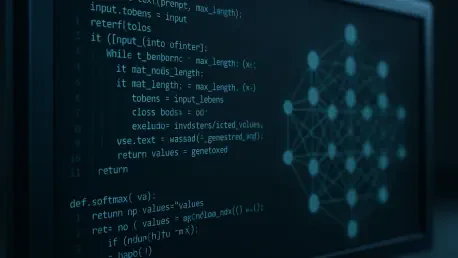In an era where artificial intelligence is often heralded as the ultimate solution to complex challenges, the promise of AI transforming software development has captured the imagination of tech leaders and developers alike, despite the enthusiastic buzz surrounding generative AI tools. These tools claim to revolutionize coding through rapid code generation from simple text prompts, but recent findings paint a far less rosy picture. A growing body of evidence suggests that the anticipated productivity leaps and transformative impacts are not materializing as expected, exposing a significant disconnect between hype and reality. This discrepancy raises critical questions about the true value of AI in one of its most celebrated applications, prompting a deeper examination of where these tools stand today.
Unpacking the Productivity Promises
Disappointing Gains in Developer Efficiency
The narrative of AI as a game-changer in coding productivity has been met with sobering data from recent analyses. A comprehensive report from a leading management consultancy indicates that despite substantial investments in AI tools, adoption rates among developers remain surprisingly low, even within organizations that have rolled out these technologies. When productivity gains do occur, they are often minimal, hovering between 10 to 15 percent at best, and rarely translate into significant financial returns. This modest impact challenges the bold claims of AI as a revolutionary force in software development, suggesting that the technology may not yet be the silver bullet many had hoped for. Instead, companies are left grappling with the reality that the expected efficiency boosts are far from guaranteed, casting doubt on the immediate benefits of these tools in day-to-day coding tasks.
Unexpected Slowdowns in Task Completion
Adding to the complexity, a study by a respected nonprofit research group has uncovered a counterintuitive trend that further undermines the productivity narrative. Developers utilizing AI tools often take 19 percent longer to complete tasks compared to those relying on traditional methods. This delay largely stems from the need to correct errors or so-called “hallucinations” generated by AI, where the output is incorrect or irrelevant. Additionally, these tools struggle to handle large, complex codebases, frequently misinterpreting context and producing flawed results. Such findings highlight a critical flaw in current AI coding solutions, as the time spent debugging and refining outputs often negates any initial time savings. The reality of slower task completion serves as a stark reminder that the technology’s current limitations can hinder rather than help developers in high-stakes environments.
Challenges Beyond Productivity Metrics
Erosion of Developer Trust in AI Tools
Beyond the underwhelming productivity stats, a significant decline in trust among developers poses another hurdle for AI coding tools. A recent survey by a prominent developer community platform reveals that even as more programmers experiment with these technologies, confidence in their reliability has notably waned. Many express frustration with outputs that are “almost right, but not quite,” pointing to a pervasive issue with accuracy and dependability. This growing dissatisfaction is particularly striking given the heavy focus and investment in AI, which many assumed would bolster trust as the technology evolved. Instead, the persistent gap between expectation and performance has left developers skeptical about integrating AI into their workflows, raising concerns about long-term adoption. This erosion of faith underscores the need for substantial improvements in precision before these tools can gain widespread acceptance.
Heightened Security Risks in AI-Generated Code
Another pressing concern lies in the security implications of relying on AI for coding. A report from a leading security firm has found that developers using AI tools generate ten times more security vulnerabilities compared to those coding manually. This alarming statistic suggests that while AI may aim to streamline development, it inadvertently introduces significant risks to software integrity. The increased likelihood of flaws and exploits in AI-generated code poses a serious threat, especially for organizations handling sensitive data or critical systems. Such findings add a layer of caution to the adoption of these tools, as the potential for security breaches could outweigh any productivity benefits. Addressing these vulnerabilities becomes paramount, as unchecked risks could lead to costly consequences in an increasingly digital landscape.
Looking Ahead to Realistic Solutions
Adapting Processes for Holistic AI Integration
As the limitations of AI in coding become clearer, attention turns to how organizations can better harness its potential through comprehensive integration. Experts suggest that realizing meaningful value from AI requires applying it across the entire software development life cycle, rather than limiting it to coding alone. This includes stages such as discovery, planning, design, testing, deployment, and maintenance. However, achieving this demands significant process changes to avoid bottlenecks, ensuring that code review, integration, and release mechanisms keep pace with AI-accelerated coding. Organizations must be prepared to overhaul their architecture, teams, and workflows to align with these demands. Only through such holistic adaptation can the technology begin to deliver on its promises, moving beyond isolated gains to create sustainable impact across development pipelines.
Anticipating Innovations Like Agentic AI
Looking to the horizon, emerging concepts such as agentic AI—systems capable of autonomously performing a series of tasks—offer a glimpse of what the future might hold for software development. Industry analysts believe that these advancements could reshape enterprise coding practices, but only for companies willing to embrace decisive transformation. The path forward hinges on adaptability, as firms must rethink traditional approaches to fully leverage these next-generation tools. While current AI coding solutions fall short of expectations, the prospect of more autonomous and intelligent systems provides a spark of optimism for addressing today’s challenges. Reflecting on past disappointments, it becomes evident that tempering expectations and focusing on strategic integration are crucial steps to avoid disillusionment. The journey of AI in coding underscores the importance of aligning implementation with realistic goals, ensuring that future innovations are grounded in practical, actionable strategies for lasting value creation.









